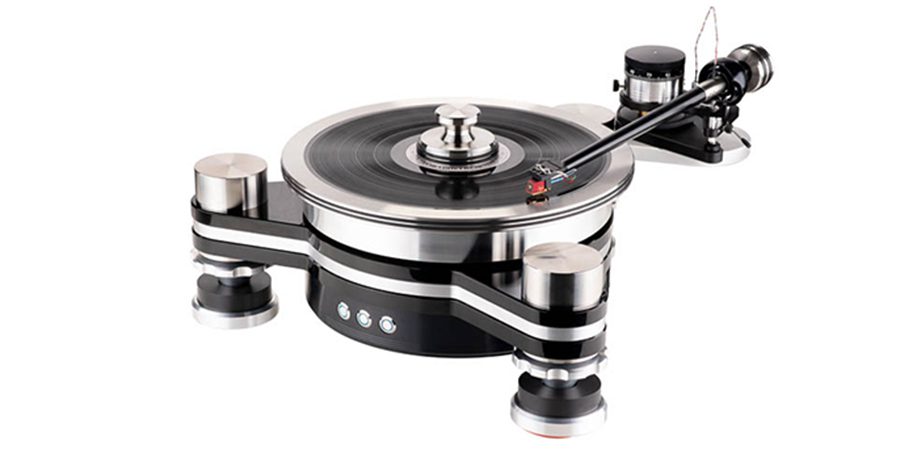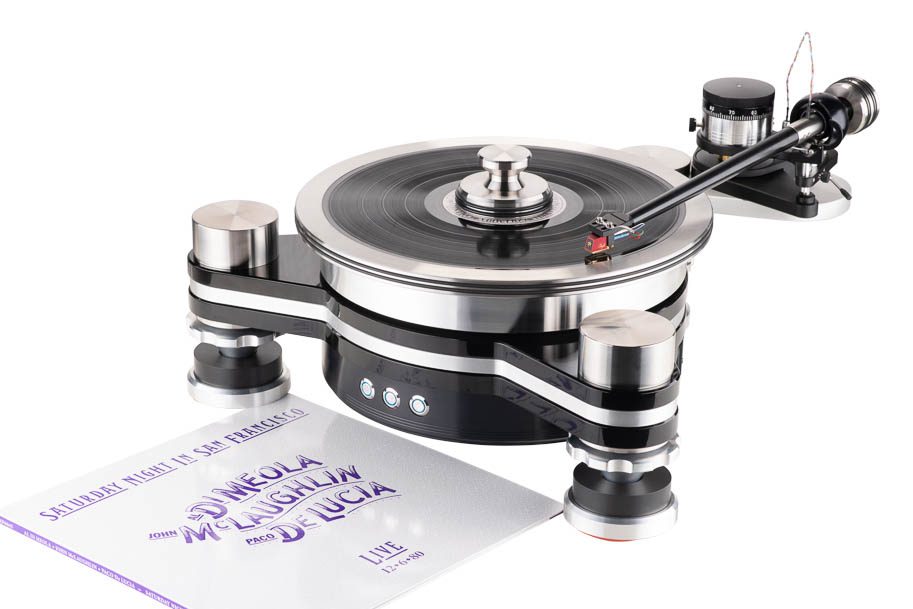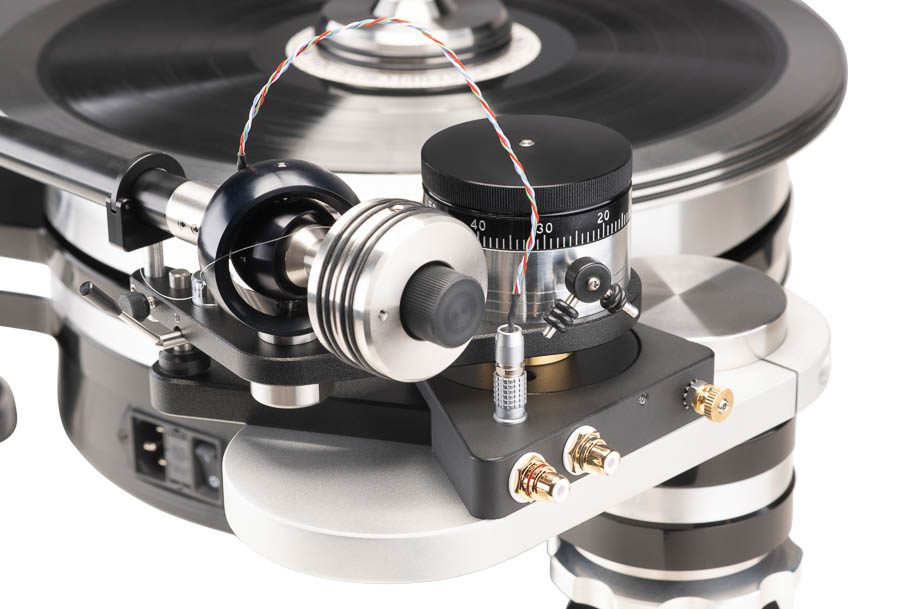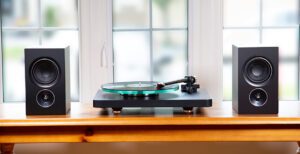
When drafting this VPI Industries Avenger Direct turntable, arm and cartridge review, I struggled to convey my overall feelings about the engineering. Then a name came into my head one morning: O. Winston Link. Ogle Winston Link (1914-2001) was a 20th-century American photographer and sound recordist. He documented the last days of steam locomotives on the Norfolk & Western Railroad. Link famously photographed trains at night. He used large format cameras and extremely powerful flash units. Link created magnificent, almost film noir images of these thunderous pieces of engineering. O. Winston Link was cataloguing the last days of steam in the late 1950s. The sheer heavy engineering of the locomotives and the heavy engineering of the photographic project shines through.
The reason for this lengthy preamble through 1950s black and white photography is not simply filler. VPI’s Avenger Direct evokes the same feelings of solid, powerful American engineering. You should be using a 10×8 field camera and lots of flashbulbs to photograph this turntable. The Avenger is the deck that should have a cow-catcher on the front! It summons up that no-nonsense ‘belt and braces’ approach. It speaks the language of that golden age of American engineering. Guys in plaid shirts wielding hammers should be building the Avenger Direct!
Avengers… Assemble!
The VPI Avenger Direct turntable, arm, and cartridge is at the top of four-strong VPI’s Avenger line. All have the same three-pod design, with a three-layer acrylic/aluminium chassis. Damping material separates each layer, and it all sits on three aluminium corner towers. The Avenger, Avenger Plus and Avenger Reference beneath the Avenger Direct are all belt-driven or rim-driven designs with an outboard motor.

Moving the motor into the turntable’s body changes the feet’ position. The other Avengers all have a foot at the front and two at the rear, whereas the Direct has the three push-button controls (off/33/45) in front meaning it has two towers to the front and one to the rear. Why is this important? The top of the towers are designed to fit an outrigger for a tonearm.
The Three Towers
While it’s possible to add up to three tonearms to an Avenger (one per tower) if you use the more common single tonearm arrangement (it’s supplied with the 12” Fatboy Gimbal as standard), that tonearm is at the rear (or the right front) of the turntable. It’s not as big a deal as it first seems as the arm-plate outrigger and the fact that the Fatboy sits to the right of its VTA tower makes it almost in the usual position for a tonearm. Still, it feels further to the back of the deck than one might get from a larger chassis, such as the 40th Anniversary VPI HW-40 we tested in Issue 177, and still forms a part of the hi-fi+ turntable arsenal to this day.
The three feet also provide a clever and simple degree of level adjustment and isolation protection. The towers end in three knurled inverted cones, which can be adjusted to provide levelling. These cones sit in a two-piece cup-like foot that isolates the turntable from its surroundings.
Back to big
That heavy American engineering I discussed earlier comes in the shape of a 2.68Nm/sec direct drive motor built into the underside of the main chassis. It has three push buttons on the front and the power inlet to the side. An exotic power cord is the last upgrade to the Avenger Direct as it makes comparatively little improvement.
Its stator is mounted in a solid billet of T6061 aluminium sitting under the platter. This makes the motor almost a sealed unit. The rotor is located in an aluminium sub-platter on the underside of that 25lb platter and speed is monitored 2,500 times per second. Suddenly all that torque makes sense… add in the Peripheral Ring and Record Clamp and you could be pushing close to 30lbs of platter around. Nevertheless, the start/stop time is around a second, not the instant start/stop of a DJ deck, but you probably aren’t scratching with a platter that weighs as much as an Icelandic Sheepdog!

Unlike most direct drive turntables, however, the rotor joins with the lower part of the platter rather than extends up to the record spindle. Remember that American engineering? Making the spindle an integral part of the platter is at once useful for anti-vibration purposes (in a direct drive where the spindle is a part of the motor, and motor-borne vibration is transmitted directly to the LP itself) and is a lot harder to manufacture to get the concentricity of the spindle perfect. VPI’s Avenger Direct turntable, arm, and cartridge combination nails this!
Fatboy slim
VPI’s top tonearms today are the Fatboy line, which uses the standard dial-adjusted VTA tower, offsetting from the armbase. The armbase is a classic, allowing a simple, yet effective way of adjusting cartridge rake angle even while a record is playing. It’s a known quantity as it’s been used in most higher-end VPI tonearms from the JMW series.
There’s a pragmatism to the Fatboy line, with 9”, 10” and 12” arm lengths available in ‘Gimbal’ and ‘UniPivot’ guise, all at the same price. Regarding turntables like the Avenger Direct, the decision is made for you in advance; it ships with a 12” Fatboy Gimbal (although you could order a second or even third tonearm in unipivot form). This arm is wired with Nordost Reference cable throughout and connects to a junction box built into the arm base using a small LEMO connector (usually found in high-end headphones).
No vampires harmed
As part of the package, we also went for a VPI Anniversary Cartridge, also known as the ‘Bloodwood’, although no vampires were harmed in making this moving coil design. Like VPI’s other cartridge designs, this is a £2,550 variant of an existing product, in this case, a Miyajima Takumi. This is almost 9g of cartridge that tracks at 2.3g, features an elliptic stylus profile, has a 16-ohm impedance, and has a very low 0.22mV output. This sets a challenge to phono stages, but a challenge always accepted by the Avenger’s price peers!
Setting up the turntable is remarkably easy, with the only real challenge is ensuring the free-standing isolation feet are in the right places to accept the attached feet. Everything goes together with the reassuring ‘thunks’ and ‘clanks’ that Brunel might like. The free-standing feet have surprisingly grippy O-rings, so moving them around isn’t as easy as it might seem. The turntable includes everything, including an alignment protractor and electronic scales. The only other issue would be to ensure the armplate is set at the right angle to the turntable itself before aligning the cartridge. Ask me how I know this! In my defence, the review sample is a demonstrator and was therefore missing a manual, but if it goes together reasonably reviewer-intuitively, that’s a good sign.
Effortless power
I’m still going with O. Winston Link regarding the sound quality. A sense of effortless power exudes from the turntable, and its sound quality reflects that. I had some trepidation that the differences between this deck and the HW-40 we use as a benchmark might be ‘nuanced’ at best. Given the Avenger Direct costs almost exactly a third more than the HW-40, that would be a damning indictment of this design. Any comparisons quickly showed how much more you get from the Avenger Direct.
It’s an extremely beefy sound, with clean and deep bass lines with the kind of control few other decks can muster. It’s also perhaps one of the most unflappable turntable designs I’ve encountered. You can play it at whisper-quiet levels and it sings. You can play it at jackhammer levels and it does the same. Other parts of the system – be it the phono stage, amp, speakers, ears, window panes, or the local noise abatement society – will fold long before the Avenger Direct runs out of puff.
Piano attack
Back to bass. It doesn’t matter whether that bass is the left hand of Alexander Toradze hammering out Stravinsky’s Petrushka on an unsuspecting piano [EMI] or the classic rattle-gun techno bass lines of Orbital on ‘The New Abnormal’ [Optical Delusion, London]; the result is the same; energetic drive and dynamic power at all volume levels. And yet, it can do that too when something more subtle is called for – such as ‘Moon Princess’ from the same Orbital album. And does it just as effortlessly.
In a way, the combination of VPI Avenger Direct turntable, arm, and Bloodwood cartridge is perfect, with the soft-edged cartridge taming the energetic sound of the turntable and arm. Still, ultimately I found the Avenger Direct gets the better deal by far. Bloodwood expressed music’s beauty in an extremely refined and elegant way, but when I wanted to play something more graunchy and rock-oriented, it was a little too ‘beauteous’ in approach. I can see the joys of this cartridge, especially in context, but the deck has more up its sleeve. Swapping out the cartridge for something more Hana-shaped made a big difference, and showed the deck’s natural exuberance is not over-the-top. If the Bloodwood’s refinement matches your musical tastes, few cartridges sound quite as lovely!
The bold and the beautiful
Regardless of cartridge, the Avenger Direct has a bold, big sound that is incredibly easy to love. It’s a cogent, coherent performer without any peaks or dips in the sound, and the mix of deck and arm is near perfect. I can imagine the unipivot version of the Fatboy being a little more upbeat, but a lot less informative at the bottom end but I’d happily stay with the Gimbal option.

This is probably where the rhythm kings begin getting hot under the collar. The sheer amount of information the Avenger Direct provides doesn’t emphasize the beat in the way a suspended turntable can. Those wanting a 4/4 beat to everything might find their bouncy castles have a greater sense of rhythmic energy. However, such decks often lack a lot of fluidity in the midrange, energy in the treble and especially precision (and depth) to the bass. This is a trade-off, but one where most would go with the widest range of strengths.
The Big Stage
One of those great strengths is Avenger Direct’s soundstaging properties. It throws out a large, wide, deep soundstage, constrained only by the record and the rest of the system. Play something with a lot of staging to hear this. The overture to The Pirates of Penzance on Decca SXL is a fine example. The Avenger Direct brings music to life in a very natural and colouration-free manner. And when you have something with a lot of soundstaging on offer, the performance stops you in your tracks. Good hi-fi is supposed to do this, and the Avenger Direct does it in spade-loads.
Vocal articulation is a turntable’s last great test of strength. ‘Venice Bitch’ from Norman F***ing Rockwell by Lana Del Rey [Polydor] lives or dies by the quality of the vocals. The VPI doesn’t disappoint. The lyrics are reproduced with utmost clarity and finesse, standing proud of the backing instruments.
The bottom line
Arm position aside, there are not a lot of strikes against the VPI Avenger Direct turntable, arm, and cartridge. Yes, there are more ornate turntable designs (some bordering on the rococo). There are ones with brighter chrome, piano gloss finishes and little touches that justify their high prices. People will also trade bottom-end depth and overall bandwidth for a more up-front rhythmic presentation. Regardless, the Avenger Direct is an honest block of engineering that sounds very good indeed.
A turntable of the Avenger Direct’s calibre requires a similarly high grade of components to accompany it. The Bloodwood cartridge might be your choice if you listen to many easy-going sounds. The turntable and arm are capable of much more.
The VPI Avenger Direct is a true high-end turntable platform. The combination of deck and tonearm make a product limited only by its medium and audio partners. The HW-40 is a great example of VPI making a direct-drive turntable. The Avenger Direct takes that direct-drive concept to astounding new levels. Also, it makes me wonder; if the Avenger Direct is this good, how much better is the flagship Vanquish?
Technical specifications
- Type: Direct drive turntable, arm and cartridge
- Chassis composition: acrylic, aluminium acrylic
- Platter: 12” aluminium (25 lb/11kg)
- Tonearm: JMW 12 Fatboy Gimbal tonearm
- Speed monitoring: 2,500 pulses/revolution speed monitoring
- Motor torque: 2.68 Nm/sec
- Start/stop time: 1 second
- Dimensions: 55.9 × 43.2 × 25.4cm
- Weight: 27kg
- Price: £36,500
Manufacturer
VPI Industries
UK distributor
Renaissance Audio
+44(0)131 555 3922
By Alan Sircom
More articles from this authorRead Next From Review
See all
PrimaLuna EVO 100 phono preamplifier
- Apr 22, 2024

Reiki Audio SuperSwitch Master Pro + Servant Pro
- Mar 27, 2024

Melco Audio N1-S38 music server
- Mar 27, 2024











